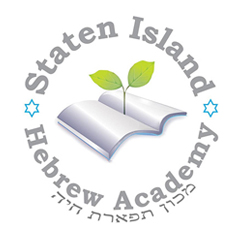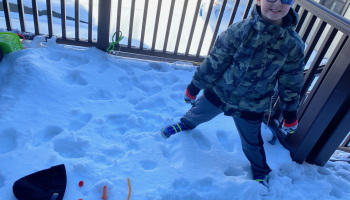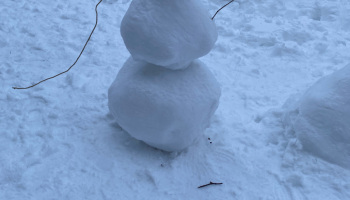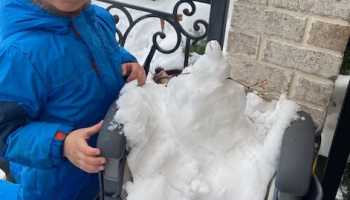Dvar Torah
Parashat Yitro
This week’s Parsha depicts the most monumental occasion of all times: Matan Torah –The giving of the Torah from G-d Himself to Bnei Yisrael. It is described as happening with great fanfare, thunder so loud that it can be “seen”, lightning, and the sound of a very loud and strong Shofar. It began with Hashem Himself saying the words of the Aseret Hadibrot -The Ten Commandments. Our forefathers found this too much and too fearful to bear, and they asked Moshe to deliver the rest of the commandments.
Out of all the Mitzvot that Hashem gave us He referred to only one as a Matana Tova – A Good Gift. That is the Holy Shabbos, Shabbat.
His words were, “In My vault, I have a Good Gift. I want to give it to Bnei Yisrael. Go and inform them.”
The Chofetz Chaim explains this with a parable.
There are many types of precious gems and many are so costly that only the wealthiest can afford them. Some are so precious that only a tremendously wealthy monarch will be able to procure them.Understandably, the wealthier/more powerful the monarch/king the finer, rarer and more precious will be the gems that he can afford and acquire.
It goes without saying that, Hashem, G-d of the entire universe, has all the silver, gold, and precious gems in His vault.
Nevertheless, out of all the possible array of gifts that Hashem could bestow on us, His nation, He chose the best. He chose Shabbos, Shabbat.
It is therefore incumbent on us, His people, the recipients of His great generous gift, to cherish it and treat it properly. There are hundreds, and with Rabbinical safeguards, thousands of nuances and intricacies necessary to properly “keep Shabbat”. Let us try a little harder to learn more about this gift, cherish it, revere it and appreciate it. We will be happier and of course our Father who loves us and gave us this “good gift” will smile at us and reward us.
Shabbat Shalom
Rabbi Y.S. Kuritsky
Judaics
Kindergarten and First Grade
We had a great week in Kindergarten Judaics! We have been reviewing the aleph bet we know and are excited to continue with a new letter next week! In First Grade Judaics, we have been reviewing the nekudot, we did reading races, reading tic tac toe, and reading I-spy. We are excited to begin a new nekuda next week! This week we learnt about Parshas Yisro, we learnt how Hashem chose Har Sinai because he was so humble and about how Hashem gave the Jewish People the Torah! We are so lucky to have the Torah, that we can learn and do mitzvot! Shabbat Shalom!
Second Grade
Hope everyone had a pleasant school break. It was wonderful seeing everyone on zoom though not the same as in person. We spent time on practicing our reading, finding specific vowels and coloring them a certain color. We enjoyed watching a video about the Purim story and learning about Parshat Bshalach and Parshat Yitro. When the Jews saw the Egyptians behind them and the Red Sea in front of them they were very scared. They prayed to Hashem for help. We learn that no matter how things look, it is important to pray to G-d and to ask Hashem for whatever we need. There have been many situations where things didn’t look promising, however with hope and prayer things turned around for the better. We learned the 10 Commandments and how fortunate we are to be the Chosen People and have the Precious Torah as our Guidebook for Life. Shabbat Shalom!
Third Grade
Although this week we were on zoom, we managed to learn so much after a refreshing break and surrounded by snow. We watched a very interesting video on the story of Purim, going all the way back to Haman (the vilain) and Mordechay (the Tzaddik) before the whole Purim saga started. They both knew each other and once when they were stranded in the desert, Haman had to sell himself as a slave to Mordechay in exchange for some water.
We practiced our Hebrew reading skills and got tested successfully. We also got tested for our general knowledge, especially on Jewish calendar subjects such as the Jewish months, days, and holidays.
Last but not least, we learnt about the Parsha from last week and this week. THis week’s Parsha is about the 10 commandments. Our daily challenge is to now learn the 10 commandments in both Hebrew and english and in correct order.
Shabbat Shalom
Mrs Ivry
5th and 6th Boys
This week was “virtually” the best we have ever had!
This week we learned about the giving of the Torah,The 10 Commandments,
and the impact they can have on our lives.
As well ,we continued our journey through the Mishna.
Ask your son if you can make a Sukkah on a camel, or a tree…..
He can tell you!
Shabbat Shalom!
7th and 8th Boys
This week the 7th and 8th grades zoomed in on zoom. One boy was actually zooming in his car! One boy zoomed in from Mexico!
We davened together, with one boy at a time taking turns to lead. We covered Parsha and learned some laws of R’chilut [similar to LashonHara]. We even had a pretty nice attendance especially considering the circumstances. it was nice to see each other. We look forward to seeing each other in person this coming Monday, G-d willing.
Elementary School
Kindergarten
Kindergarten did an amazing job on zoom this week. I am so proud of them! They read a story about a blue ox. They learned how to identify the setting of a story. They learned how to read and spell many words with S blends. In math they practiced filling in the missing parts of number bonds. They did an excellent job figuring out where each number should go in a number bond and how to solve to find the missing whole or the missing parts. They also practiced adding and subtracting with the fact family 5,3,2. In science they learned all about force and speed. They learned about push and pull and that the amount of force they use can change the speed of an object. In social studies they learned about Groundhog’s Day. They made predictions, filled in a graph, and then they watched the groundhog Phil and the groundhog Chuck emerging from their burrows to see if their predictions were correct.
Second Grade
In science, students learned about how fossils are formed and why paleontologists study fossils.
Third Grade
This week grade 3 students reviewed the various parts of speech we have covered this school year (thus far). During our math lessons, students continued developing abilities to decipher multi step word problems. We concentrated on how to recognize which operation would be the most appropriate (and when) to use to solve during each step of the problem before we can reach the final result. They also began to review some of the rules of multiplication. During social studies, we continued to learn about Earth’s resources and how they contribute to a community’s growth and development. During computer class, students learned of the different formats and types of programs and files available to them on a computer.
In science, students started a new chapter about Earth’s resources. They learned about the differences between rocks and minerals. An “edible soil” project was given to students as a bonus along with a soil worksheet.
Miss Sasha
Fourth Grade
This week in math we reviewed operations on fractions and prepared for the test that is coming up on Monday.
In ELA for Explanatory writing unit we created a class recipe book of favorite dishes and desserts.
Completed reading comprehension packets for our preparation for the state test.
In Social Studies we explored the geography, climate, resources and major industries of the Midwest.
In science, students learned that Earthquakes and Volcanoes can cause rapid changes to Earth’s surface. Also the process of Weathering, erosion, deposition, and mountain building change Earth’s surface.
Fifth Grade
Greetings and salutations!
This has been a rather busy week for the 5th grade.
In grammar, the students learned about adjectives! They practiced identifying adjectives and the nouns that they describe. In writing, the 5th graders learned about compare and contrast text structure and cause and effect text structure. As a result of passages in writing the students also got to learn all sorts of facts about water, corals, kelp, and even tunamis and hurricanes.
They also continued to work on their essays on the theme of Holes.
In social studies, the 5th grade began learning about the earliest people to settle the western Hemisphere. They also started to learn about the Olmec civilization in Central America. In our journey to learn about the Olmecs, the students learned that natural rubber comes from rubber trees. They were very interested!
In math, 5th reviewed the area and perimeter of rectangles and triangles. They also learned how to find the value of a missing dimension given area or perimeter of a rectangle.
Ms. Ortiz would like to commend all of 5th grade for being incredibly attentive and always following directions!
In science, students learned and described the layers of the Earth, explained how mountains were formed, what causes volcanoes and Earthquakes.
A virtual mini-lab was performed from students and Mrs. Belli during science class.
Middle School
Middle School ELA and Social Studies
6th Grade had a pretty busy week!
In ELA, we wrote our essay on conflict in Gary Paulsen’s Hatchet. Students analyzed two different types of conflict in the novel and wrote a wonderful essay. Great job, everyone! We also started a new unit in vocabulary, and began our novel study of Christopher Paul Curtis’s novel, Bud, not Buddy.
Happy Friday everyone!
In social studies, the 6th grade began learning about the last of the river valley civilizations- ancient China! They learned about the geography of China. They also learned about Yu the Great and his heroic deeds. Finally, the 6th graders began learning about the Shang dynasty.
I’m looking forward to seeing the students in person and continuing this journey through the ancient world.
7th grade had a busy week as well!
In ELA, we discussed rhyme, alliteration, and repetition in both poetry and prose and how it can help with understanding the mood and meaning of fiction. Students wrote beautiful paragraphs practicing for the State Test!
We also started our next novel unit! Students are reading Jeanne Wakatsuki’s Farewell to Manzanar.
In Social Studies, we started our unit on Thomas Jefferson’s presidency and the lead-up to the War of 1812. We had a very productive class discussion on present-day mores vs. historic mores, and how our perspective can color our understanding of the past.
8th Graders had a good week!
In ELA, students reviewed different types of figurative language and their use in both poetry and prose to convey mood and theme. Students read poems, including a sonnet by Shakespeare, and wrote wonderful paragraphs discussing literary devices and mood.
We also started our next novel unit! We are reading S.E. Hinton’s The Outsiders. We began with a discussion of the era in which the novel was written.
In Social Studies, we learned about the causes of World War I. Through class discussion, short films, and both primary and secondary sources, students learned all about the atmosphere in Europe that led to the beginning of the war. Mrs. Hazen is particularly impressed with their hard work on our first quiz! Many students did a phenomenal job on it, especially Rachel, Taylor, Eliana, Yosi, and Orian!
Middle School Math
8th honors learned how to find the inverse of functions and execute different operations with two or more functions.
8th learned how to graph a linear equation in standard form and slope intercept form.
7th honors finished their module on experimental probability.
7th learned how to calculate the area of composite shapes.
6th finished the module on generating equivalent numerical expressions.
?Shoutouts:?
8H – Shai K. for being a very diligent worker especially while learning remotely.
8 – Rachel D. for always giving her best effort.
7H – Anna G. and Ariella S. for being very attentive while going over classwork and homework.
7 – Lana M. for showing me a different way to see a problem.
6 – Gabby F. for always logging in to my classes early.
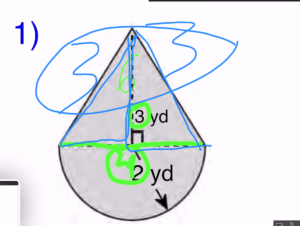
Middle School Science
6th grade
Students learned the names and order of the layers of Earth’s atmosphere with a drawing activity. Students reviewed the different forms of energy transfer and identified the definition and diagram for each, then described or drew a real-world example of each.
